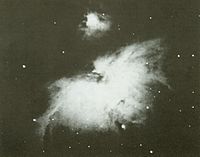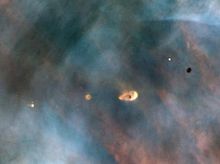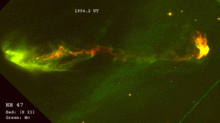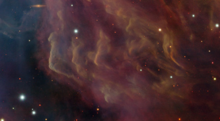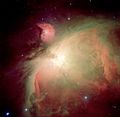- Orion Nebula
-
Orion Nebula 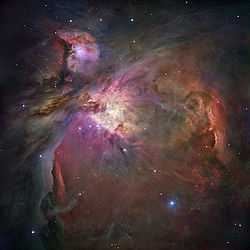
The entire Orion Nebula in visible light.
Credit: NASA/ESAObservation data: J2000 epoch Type Reflection and Emission[1] Right ascension 05h 35m 17.3s[2] Declination -05° 23′ 28″[2] Distance 1,344±20 ly (412 pc)[3] Apparent magnitude (V) +4.0[4] Apparent dimensions (V) 65×60 arcmins[5] Constellation Orion Physical characteristics Radius 12 ly[a] Absolute magnitude (V) — Notable features Trapezium cluster Other designations NGC 1976, M42,
LBN 974, Sharpless 281See also: Diffuse nebula, Lists of nebulae The Orion Nebula (also known as Messier 42, M42, or NGC 1976) is a diffuse nebula situated south[b] of Orion's Belt. It is one of the brightest nebulae, and is visible to the naked eye in the night sky. M42 is located at a distance of 1,344 ± 20 light years[3][6] and is the closest region of massive star formation to Earth. The M42 nebula is estimated to be 24 light years across. Older texts frequently referred to the Orion Nebula as the Great Nebula in Orion or the Great Orion Nebula.
The Orion Nebula is one of the most scrutinized and photographed objects in the night sky, and is among the most intensely studied celestial features.[7] The nebula has revealed much about the process of how stars and planetary systems are formed from collapsing clouds of gas and dust. Astronomers have directly observed protoplanetary disks, brown dwarfs, intense and turbulent motions of the gas, and the photo-ionizing effects of massive nearby stars in the nebula. There are also supersonic "bullets" of gas piercing the dense hydrogen clouds of the Orion Nebula. Each bullet is ten times the diameter of Pluto's orbit and tipped with iron atoms glowing bright blue. They were probably formed one thousand years ago from an unknown violent event.[8]
Contents
General information
The Nebula is in fact part of a much larger nebula that is known as the Orion Molecular Cloud Complex. The Orion Molecular Cloud Complex extends throughout the constellation of Orion and includes Barnard's Loop, the Horsehead Nebula, M43, M78 and the Flame Nebula. Stars are forming throughout the Orion Nebula, and due to this heat-intensive process the region is particularly prominent in the infrared.
The nebula is visible with the naked eye even from areas affected by some light pollution. It is seen as the middle "star" in the sword of Orion, which are the three stars located south of Orion's Belt. The star appears fuzzy to sharp-eyed observers, and the nebulosity is obvious through binoculars or a small telescope.
The Orion Nebula contains a very young open cluster, known as the Trapezium due to the asterism of its primary four stars. Two of these can be resolved into their component binary systems on nights with good seeing, giving a total of six stars. The stars of the Trapezium, along with many other stars, are still in their early years. The Trapezium may be a component of the much-larger Orion Nebula Cluster, an association of about 2,000 stars within a diameter of 20 light years. Two million years ago this cluster may have been the home of the runaway stars AE Aurigae, 53 Arietis, and Mu Columbae, which are currently moving away from the nebula at velocities greater than 100 km/s.[9]
Observers have long noted a distinctive greenish tint to the nebula, in addition to regions of red and areas of blue-violet. The red hue is well-understood to be caused by Hα recombination line radiation at a wavelength of 656.3 nm. The blue-violet coloration is the reflected radiation from the massive O-class stars at the core of the nebula.
The green hue was a puzzle for astronomers in the early part of the 20th century because none of the known spectral lines at that time could explain it. There was some speculation that the lines were caused by a new element, and the name "nebulium" was coined for this mysterious material. With better understanding of atomic physics, however, it was later determined that the green spectra was caused by a low-probability electron transition in doubly ionized oxygen, a so-called "forbidden transition". This radiation was all but impossible to reproduce in the laboratory because it depended on the quiescent and nearly collision-free environment found in deep space.[10]
History
There is no known written record of the nebulosity in any astronomical records prior to the invention of the telescope in the 17th century. There has been speculation that the Mayans of Central America may have seen it as part of their "Three Hearthstones" of creation myth, suspected to have been made up of two stars at the base of Orion, Rigel and Saiph, and one star at the tip of his belt, Alnitak, a nearly perfect triangle with Orion's Sword (including the Orion Nebula) in the middle as the smudge of smoke from Copal incense or the embers of creation.[11][12] Neither Ptolemy in the Almagest nor Al Sufi in his Book of Fixed Stars noted this nebula, even though they both listed patches of nebulosity elsewhere in the night sky.This nebula was also not mentioned by Galileo, even though he made telescope observations of this part of the constellation in 1610 and 1617.[13] This has led to some speculation that a flare-up of the illuminating stars may have increased the brightness of the nebula.[14]
The defuse nebulous nature of the Orion Nebula is generally credited as being first discovered in 1610 when French astronomer Nicolas-Claude Fabri de Peiresc made a record of observed it with a refracting telescope purchased by his patron Guillaume du Vair. The first published observation of the nebula was a (somewhat ambiguous) account by Jesuit mathematician and astronomer Cysatus of Lucerne in a book about a bright comet in 1618. It was independently discovered by several prominent astronomers in the following years, including Christiaan Huygens in 1656 (whose sketch was the first published in 1659). Charles Messier first noted the nebula on March 4, 1769, and he also noted three of the stars in Trapezium. (The first detection of these three stars is now credited to Galileo in 1617, but he did not notice the surrounding nebula—possibly due to the narrow field of vision of his early telescope.) Charles Messier published the first edition of his catalog of deep sky objects in 1774 (completed in 1771).[15] As the Orion Nebula was the 42nd object in his list, it became identified as M42.
In 1865 English amateur astronomer William Huggins used his visual spectroscopy method to examine the nebula showing it, like other nebula he had examined, was made up of "luminous gas".[16] On September 30, 1880 Henry Draper used the new dry plate photographic process with an 11-inch (28 cm) refracting telescope to make a 51-minute exposure of the Orion Nebula, the first instance of astrophotography of a nebula in history. Another set of photographs of the nebula in 1883 saw breakthrough in astronomical photography when amateur astronomer Andrew Ainslie Common used the dry plate process to record several images in exposures up to 60 minutes with a 36-inch (91 cm) reflecting telescope that he constructed in the backyard of his home in Ealing, outside London. These images for the first time showed stars and nebula detail too faint to be seen by the human eye.[17]
In 1902, Vogel and Eberhard discovered differing velocities within the nebula and by 1914 astronomers at Marseilles had used the interferometer to detect rotation and irregular motions. Campbell and Moore confirmed these results using the spectrograph, demonstrating turbulence within the nebula.[18]
In 1931, Robert J. Trumpler noted that the fainter stars near the Trapezium formed a cluster, and he was the first to name them the Trapezium cluster. Based on their magnitudes and spectral types, he derived a distance estimate of 1,800 light years. This was three times further than the commonly accepted distance estimate of the period but was much closer to the modern value.[19]
In 1993, the Hubble Space Telescope first observed the Orion Nebula. Since then, the nebula has been a frequent target for HST studies. The images have been used to build a detailed model of the nebula in three dimensions. Protoplanetary disks have been observed around most of the newly formed stars in the nebula, and the destructive effects of high levels of ultraviolet energy from the most massive stars have been studied.[20]
In 2005, the Advanced Camera for Surveys instrument of the Hubble Space Telescope finished capturing the most detailed image of the nebula yet taken. The image was taken through 104 orbits of the telescope, capturing over 3,000 stars down to the 23rd magnitude, including infant brown dwarfs and possible brown dwarf binary stars.[21] A year later, scientists working with the HST announced the first ever masses of a pair of eclipsing binary brown dwarfs, 2MASS J05352184–0546085. The pair are located in the Orion Nebula and have approximate masses of 0.054 M☉ and 0.034 M☉ respectively, with an orbital period of 9.8 days. Surprisingly, the more massive of the two also turned out to be the less luminous.[22]
Structure
The entirety of the Orion Nebula extends across a 10° region of the sky, and includes neutral clouds of gas and dust, associations of stars, ionized volumes of gas, and reflection nebulae.
The nebula forms a roughly spherical cloud that peaks in density near the core.[23] The cloud has a temperature ranging up to 10,000 K, but this temperature falls dramatically near the edge of the nebula.[23] Unlike the density distribution, the cloud displays a range of velocities and turbulence, particularly around the core region. Relative movements are up to 10 km/s (22,000 mi/h), with local variations of up to 50 km/s and possibly more.
The current astronomical model for the nebula consists of an ionized region roughly centered on Theta1 Orionis C, the star responsible for most of the ultraviolet ionizing radiation. (It emits 3-4 times as much photoionizing light as the next brightest star, Theta2 Orionis A.)[24] This is surrounded by an irregular, concave bay of more neutral, high-density cloud, with clumps of neutral gas lying outside the bay area. This in turn lies on the perimeter of the Orion Molecular Cloud.
Observers have given names to various features in the Orion Nebula. The dark lane that extends from the north toward the bright region is called the "Fish's Mouth". The illuminated regions to both sides are called the "Wings". Other features include "The Sword", "The Thrust", and "The Sail".[25]
Stellar formation
The Orion Nebula is an example of a stellar nursery where new stars are being born. Observations of the nebula have revealed approximately 700 stars in various stages of formation within the nebula.
Recent observations with the Hubble Space Telescope have yielded the major discovery of protoplanetary disks within the Orion Nebula, which have been dubbed proplyds.[26] HST has revealed more than 150 of these within the nebula, and they are considered to be systems in the earliest stages of solar system formation. The sheer numbers of them have been used as evidence that the formation of star systems is fairly common in our universe.
Stars form when clumps of hydrogen and other gases in an H II region contract under their own gravity. As the gas collapses, the central clump grows stronger and the gas heats to extreme temperatures by converting gravitational potential energy to thermal energy. If the temperature gets high enough, nuclear fusion will ignite and form a protostar. The protostar is 'born' when it begins to emit enough radiative energy to balance out its gravity and halt gravitational collapse.
Typically, a cloud of material remains a substantial distance from the star before the fusion reaction ignites. This remnant cloud is the protostar's protoplanetary disk, where planets may form. Recent infrared observations show that dust grains in these protoplanetary disks are growing, beginning on the path towards forming planetesimals.[27]
Once the protostar enters into its main sequence phase, it is classified as a star. Even though most planetary disks can form planets, observations show that intense stellar radiation should have destroyed any proplyds that formed near the Trapezium group, if the group is as old as the low mass stars in the cluster.[20] Since proplyds are found very close to the Trapezium group, it can be argued that those stars are much younger than the rest of the cluster members.[c]
Stellar wind and effects
Once formed, the stars within the nebula emit a stream of charged particles known as a stellar wind. Massive stars and young stars have much stronger stellar winds than the Sun.[28] The wind forms shock waves or hydrodynamical instabilities when it encounters the gas in the nebula, which then shapes the gas clouds. The shock waves from stellar wind also play a large part in stellar formation by compacting the gas clouds, creating density inhomogeneities that lead to gravitational collapse of the cloud.
There are three different kinds of shocks in the Orion Nebula. Many are featured in Herbig-Haro objects:[30]
- Bow shocks are stationary and are formed when two particle streams collide with each other. They are present near the hottest stars in the nebula where the stellar wind speed is estimated to be thousands of kilometers per second and in the outer parts of the nebula where the speeds are tens of kilometers per second. Bow shocks can also form at the front end of stellar jets when the jet hits interstellar particles.
- Jet-driven shocks are formed from jets of material sprouting off newborn T Tauri stars. These narrow streams are traveling at hundreds of kilometers per second, and become shocks when they encounter relatively stationary gases.
- Warped shocks appear bow-like to an observer. They are produced when a jet-driven shock encounters gas moving in a cross-current.
- The interaction of the stellar wind with the surrounding cloud also forms "waves" which are believed to be due to the hydrodynamical Kelvin-Helmholtz instability.[31]
The dynamic gas motions in M42 are complex, but are trending out through the opening in the bay and toward the Earth.[23] The large neutral area behind the ionized region is currently contracting under its own gravity.
Evolution
Interstellar clouds like the Orion Nebula are found throughout galaxies such as the Milky Way. They begin as gravitationally bound blobs of cold, neutral hydrogen, intermixed with traces of other elements. The cloud can contain hundreds of thousands of solar masses and extend for hundreds of light years. The tiny force of gravity that could compel the cloud to collapse is counter-balanced by the very faint pressure of the gas in the cloud.
Whether due to collisions with a spiral arm, or through the shock wave emitted from supernovae, the atoms are precipitated into heavier molecules and the result is a molecular cloud. This presages the formation of stars within the cloud, usually thought to be within a period of 10-30 million years, as regions pass the Jeans mass and the destabilized volumes collapse into disks. The disk concentrates at the core to form a star, which may be surrounded by a protoplanetary disk. This is the current stage of evolution of the nebula, with additional stars still forming from the collapsing molecular cloud. The youngest and brightest stars we now see in the Orion Nebula are thought to be less than 300,000 years old,[32] and the brightest may be only 10,000 years in age.
Some of these collapsing stars can be particularly massive, and can emit large quantities of ionizing ultraviolet radiation. An example of this is seen with the Trapezium cluster. Over time the ultraviolet light from the massive stars at the center of the nebula will push away the surrounding gas and dust in a process called photo evaporation. This process is responsible for creating the interior cavity of the nebula, allowing the stars at the core to be viewed from Earth.[7] The largest of these stars have short life spans and will evolve to become supernovae.
Within about 100,000 years, most of the gas and dust will be ejected. The remains will form a young open cluster, a cluster of bright, young stars surrounded by wispy filaments from the former cloud. The Pleiades is a famous example of such a cluster.
Gallery
-
Orion Nebula Complex including M42, M43, Running Man Nebula (NGC 1973, 1975, and 1977) and much of the surrounding nebulosity.
-
This wide-field view of the Orion Nebula (Messier 42), was taken with the VISTA infrared survey telescope at ESO’s Paranal Observatory in Chile. Credit ESO/J. Emerson/VISTA.
-
Orion by Spitzer.
See also
- List of Messier objects
- List of diffuse nebulae
- New General Catalogue
- Orion Nebula in fiction
- Hubble 3D (2010), an IMAX film with an elaborate CGI "fly-through" of the Orion Nebula
Notes
- ^ 1,270 × tan( 66′ / 2 ) = 12 ly. radius
- ^ From temperate zones in the Northern Hemisphere, the nebula appears below the Belt of Orion; from temperate zones in the Southern Hemisphere the nebula appears above the Belt.
- ^ C. Robert O'Dell commented about this Wikipedia article, "The only egregious error is the last sentence in the Stellar Formation section. It should actually read 'Even though most planetary disks can form planets, observations show that intense stellar radiation should have destroyed any proplyds that formed near the Trapezium group, if the group is as old as the low mass stars in the cluster. Since proplyds are found very close to the Trapezium group, it can be argued that those stars are much younger than the rest of the cluster members.'"
References
- ^ Will Gater, Anton Vamplew, The Practical Astronomer, page 242
- ^ a b "SIMBAD Astronomical Database". Results for NGC 7538. http://simbad.u-strasbg.fr/Simbad. Retrieved 2006-10-20.
- ^ a b Reid, M. J.; et al. (2009). "Trigonometric Parallaxes of Massive Star Forming Regions: VI. Galactic Structure, Fundamental Parameters and Non-Circular Motions". Astrophysical Journal 700: 137. arXiv:0902.3913. Bibcode 2009ApJ...700..137R. doi:10.1088/0004-637X/700/1/137.
- ^ "NGC 1976 = M42". SEDS.org. http://www.seds.org/~spider/ngc/ngc.cgi?NGC+1976. Retrieved 2009-12-13.
- ^ Revised NGC Data for NGC 1976 per Wolfgang Steinicke's NGC/IC Database Files.
- ^ Hirota, Tomoya; Bushimata; Choi; Honma; Imai; Iwadate; Jike; Kameno et al.; et al. (2007). "Distance to Orion KL Measured with VERA". Publications of the Astronomical Society of Japan 59 (5): 897–903. Bibcode 2007PASJ...59..897H.
- ^ a b Press release, "Astronomers Spot The Great Orion Nebula's Successor", Harvard-Smithsonian Center for Astrophysics, 2006.
- ^ "Gemini's Laser Vision Reveals Striking New Details in Orion Nebula". Gemini Observatory. 2007-03-22. http://www.gemini.edu/index.php?q=node/226. Retrieved 2010-06-01.
- ^ Blaauw, A.; Morgan, W. W. (1954). "The Space Motions of AE Aurigae and μ Columbae with Respect to the Orion Nebula". Astrophysical Journal 119: 625. Bibcode 1954ApJ...119..625B. doi:10.1086/145866.
- ^ Bowen, Ira Sprague (1927). "The Origin of the Nebulium Spectrum". Nature 120 (3022): 473. Bibcode 1927Natur.120..473B. doi:10.1038/120473a0.
- ^ Davíd Carrasco The Oxford encyclopedia of Mesoamerican cultures: the civilizations of Mexico and Central America, Oxford University Press, 2001, page 165
- ^ American astronomer and author Ed Krupp, Krupp, Edward C. (February 1999). "Igniting the Hearth". Sky & Telescope: 94. Archived from the original on September 30, 2007. http://web.archive.org/web/20070930222028/http://pqasb.pqarchiver.com/skyandtelescope/access/886319051.html?dids=886319051:886319051&FMT=CITE&FMTS=CITE:PAGE&date=Feb+1999&author=E+C+Krupp&desc=Igniting+the+Hearth. Retrieved 2006-10-19.
- ^ James, Andrew (October 29, 2005). "The Great Orion Nebula: M42 and M43". Southern Astronomical Delights. http://homepage.mac.com/andjames/Page204.htm. Retrieved 2006-10-27.
- ^ Tibor Herczeg, Norman (January 22, 1999). "The Orion Nebula: A chapter of early nebular studies". History of Astronomy. http://www.astro.uni-bonn.de/~pbrosche/aa/acta/vol03/acta03_246.html. Retrieved 2006-10-27.
- ^ Messier, Charles (1774). "Catalogue des Nébuleuses & des amas d'Étoiles, que l'on découvre parmi les Étoiles fixes sur l'horizon de Paris; observées à l'Observatoire de la Marine, avec differens instruments". Mémoires de l'Académie Royale des Sciences (Paris). http://seds.org/messier/Xtra/history/m-cat71.html.[dead link]
- ^ Barbara J. Becker, Eclecticism, Opportunism, and the Evolution of a New Research Agenda: William and Margaret Huggins and the Origins of Astrophysics, CHAPTER 2—PART 3
- ^ J. B. Hearnshaw,The measurement of starlight: two centuries of astronomical photometry, page 122
- ^ Campbell, W. W.; Moore, J. H. (1917). "On the Radial Velocities of the Orion Nebula". Publications of the Astronomical Society of the Pacific 29 (169): 143. Bibcode 1917PASP...29..143C. doi:10.1086/122612.
- ^ Trumpler, Robert Julius (1931). "The Distance of the Orion Nebula". Publications of the Astronomical Society of the Pacific 43 (254): 255. Bibcode 1931PASP...43..255T. doi:10.1086/124134.
- ^ a b David F. Salisbury, 2001, "Latest investigations of Orion Nebula reduce odds of planet formation".
- ^ Robberto, M.; O'Dell; Hillenbrand; Simon; Soderblom; Feigelson; Krist; McCullough et al.; et al. (2005). "An overview of the HST Treasury Program on the Orion Nebula". Bulletin of the American Astronomical Society 37: 1404. Bibcode 2005AAS...20714601R. See also see the NASA press release.
- ^ K.G. Stassun, R.D. Mathieu and J.A. Valenti (2006). "Discovery of two young brown dwarfs in an eclipsing binary system". Nature 440 (7082): 311–314. Bibcode 2006Natur.440..311S. doi:10.1038/nature04570.
- ^ a b c Balick, B.; Gammon, R. H.; Hjellming, R. M. (1974). "The structure of the Orion nebula". Publications of the Astronomical Society of the Pacific 86: 616. Bibcode 1974PASP...86..616B. doi:10.1086/129654.
- ^ O'Dell, C. R. (2001). "Structure of the Orion Nebula". Publications of the Astronomical Society of the Pacific 113 (779): 29. Bibcode 2001PASP..113...29O. doi:10.1086/317982.
- ^ "M-42", Students for the Exploration and Development of Space, April 12, 2006.
- ^ McCaughrean, Mark J.; O'dell, C. Robert. (1996). "Direct Imaging of Circumstellar Disks in the Orion Nebula". Astronomical Journal 111: 1977. Bibcode 1996AJ....111.1977M. doi:10.1086/117934.
- ^ Kassis, Marc; et al. (2006). "Mid-Infrared Emission at Photodissociation Regions in the Orion Nebula". Astrophysical Journal 637 (2): 823–837. Bibcode 2006ApJ...637..823K. doi:10.1086/498404. See also the press release
- ^ Ker Than, 11 January 2006, "The Splendor of Orion: A Star Factory Unveiled", Space.com
- ^ Patrick Hartigan. Herbig-Haro Jet Movies from HST, Physics and Astronomy Dept., Rice University
- ^ "Mapping Orion's Winds", January 16, 2006, Vanderbilt News Service
- ^ Denise Chow. Young stars blamed for space cloud ripples, MSNBC.com
- ^ "Detail of the Orion Nebula", HST image and text.
External links
- Animated tour of the Orion Nebula, University of Glamorgan
- Orion Nebula observed by Chandra/HST
- Orion Nebula observed by Gemini Observatory
- Orion Nebula at ESA/Hubble
- Messier 42, SEDS Messier pages and specifically NGC 1976.
- January 2006 Hubble Space Telescope image of the Orion Nebula
- January 2006 Hubble Space Telescope image of the Trapezium cluster
- Orion Nebula M42, Hubble Images
- Remarkable new views captured of Orion Nebula, SpaceFlight Now, 2001.
- NightSkyInfo.com - The Great Orion Nebula
- Computer visualization of Orion Nebula. Data gathered from the Hubble Space Telescope and ground-based sensors were combined to form a 3D volume visualization of the nebula. Narration of the planetarium-like flythrough describes notable features and views from angles not possible from Earth. Link contains downloadable MPEG and Quicktime movies of flythrough.
- Astronomy Picture of the Day
- Spitzer's Orion 2010 April 10
- Planetary Systems Now Forming in Orion 2009 December 22
- Great Orion Nebulae 2008 October 23
- The Orion Nebula on WikiSky: DSS2, SDSS, GALEX, IRAS, Hydrogen α, X-Ray, Astrophoto, Sky Map, Articles and images
Messier objects List M1 · M2 · M3 · M4 · M5 · M6 · M7 · M8 · M9 · M10 · M11 · M12 · M13 · M14 · M15 · M16 · M17 · M18 · M19 · M20 · M21 · M22 · M23 · M24 · M25 · M26 · M27 · M28 · M29 · M30 · M31 · M32 · M33 · M34 · M35 · M36 · M37 · M38 · M39 · M40 · M41 · M42 · M43 · M44 · M45 · M46 · M47 · M48 · M49 · M50 · M51 · M52 · M53 · M54 · M55 · M56 · M57 · M58 · M59 · M60 · M61 · M62 · M63 · M64 · M65 · M66 · M67 · M68 · M69 · M70 · M71 · M72 · M73 · M74 · M75 · M76 · M77 · M78 · M79 · M80 · M81 · M82 · M83 · M84 · M85 · M86 · M87 · M88 · M89 · M90 · M91 · M92 · M93 · M94 · M95 · M96 · M97 · M98 · M99 · M100 · M101 · M102 · M103 · M104 · M105 · M106 · M107 · M108 · M109 · M110See also  Book:Messier objects ·
Book:Messier objects ·  Category:Messier objects
Category:Messier objects  Portal:Astronomy
Portal:AstronomySharpless catalog Sh2-1 · Sh2-2 · Sh2-3 · Sh2-4 · Sh2-5 · Sh2-6 · Sh2-7 · Sh2-8 · Sh2-9 · Sh2-10 · Sh2-11 · Sh2-12 · Sh2-13 · Sh2-14 · Sh2-15 · Sh2-16 · Sh2-17 · Sh2-18 · Sh2-19 · Sh2-20 · Sh2-21 · Sh2-22 · Sh2-23 · Sh2-24 · Sh2-25 · Sh2-26 · Sh2-27 · Sh2-28 · Sh2-29 · Sh2-30 · Sh2-31 · Sh2-32 · Sh2-33 · Sh2-34 · Sh2-35 · Sh2-36 · Sh2-37 · Sh2-38 · Sh2-39 · Sh2-40 · Sh2-41 · Sh2-42 · Sh2-43 · Sh2-44 · Sh2-45 · Sh2-46 · Sh2-47 · Sh2-48 · Sh2-49 · Sh2-50 · Sh2-51 · Sh2-52 · Sh2-53 · Sh2-54 · Sh2-55 · Sh2-56 · Sh2-57 · Sh2-58 · Sh2-59 · Sh2-60 · Sh2-61 · Sh2-62 · Sh2-63 · Sh2-64 · Sh2-65 · Sh2-66 · Sh2-67 · Sh2-68 · Sh2-69 · Sh2-70 · Sh2-71 · Sh2-72 · Sh2-73 · Sh2-74 · Sh2-75 · Sh2-76 · Sh2-77 · Sh2-78 · Sh2-79 · Sh2-80 · Sh2-81 · Sh2-82 · Sh2-83 · Sh2-84 · Sh2-85 · Sh2-86 · Sh2-87 · Sh2-88 · Sh2-89 · Sh2-90 · Sh2-91 · Sh2-92 · Sh2-93 · Sh2-94 · Sh2-95 · Sh2-96 · Sh2-97 · Sh2-98 · Sh2-99 · Sh2-100 · Sh2-101 · Sh2-102 · Sh2-103 · Sh2-104 · Sh2-105 · Sh2-106 · Sh2-107 · Sh2-108 · Sh2-109 · Sh2-110 · Sh2-111 · Sh2-112 · Sh2-113 · Sh2-114 · Sh2-115 · Sh2-116 · Sh2-117 · Sh2-118 · Sh2-119 · Sh2-120 · Sh2-121 · Sh2-122 · Sh2-123 · Sh2-124 · Sh2-125 · Sh2-126 · Sh2-127 · Sh2-128 · Sh2-129 · Sh2-130 · Sh2-131 · Sh2-132 · Sh2-133 · Sh2-134 · Sh2-135 · Sh2-136 · Sh2-137 · Sh2-138 · Sh2-139 · Sh2-140 · Sh2-141 · Sh2-142 · Sh2-143 · Sh2-144 · Sh2-145 · Sh2-146 · Sh2-147 · Sh2-148 · Sh2-149 · Sh2-150 · Sh2-151 · Sh2-152 · Sh2-153 · Sh2-154 · Sh2-155 · Sh2-156 · Sh2-157 · Sh2-158 · Sh2-159 · Sh2-160 · Sh2-161 · Sh2-162 · Sh2-163 · Sh2-164 · Sh2-165 · Sh2-166 · Sh2-167 · Sh2-168 · Sh2-169 · Sh2-170 · Sh2-171 · Sh2-172 · Sh2-173 · Sh2-174 · Sh2-175 · Sh2-176 · Sh2-177 · Sh2-178 · Sh2-179 · Sh2-180 · Sh2-181 · Sh2-182 · Sh2-183 · Sh2-184 · Sh2-185 · Sh2-186 · Sh2-187 · Sh2-188 · Sh2-189 · Sh2-190 · Sh2-191 · Sh2-192 · Sh2-193 · Sh2-194 · Sh2-195 · Sh2-196 · Sh2-197 · Sh2-198 · Sh2-199 · Sh2-201 · Sh2-202 · Sh2-203 · Sh2-204 · Sh2-205 · Sh2-206 · Sh2-207 · Sh2-208 · Sh2-209 · Sh2-210 · Sh2-211 · Sh2-212 · Sh2-213 · Sh2-214 · Sh2-215 · Sh2-216 · Sh2-217 · Sh2-218 · Sh2-219 · Sh2-220 · Sh2-221 · Sh2-222 · Sh2-223 · Sh2-224 · Sh2-225 · Sh2-226 · Sh2-227 · Sh2-228 · Sh2-229 · Sh2-230 · Sh2-231 · Sh2-232 · Sh2-233 · Sh2-234 · Sh2-235 · Sh2-236 · Sh2-237 · Sh2-238 · Sh2-239 · Sh2-240 · Sh2-241 · Sh2-242 · Sh2-243 · Sh2-244 · Sh2-245 · Sh2-246 · Sh2-247 · Sh2-248 · Sh2-249 · Sh2-250 · Sh2-251 · Sh2-252 · Sh2-253 · Sh2-254 · Sh2-255 · Sh2-256 · Sh2-257 · Sh2-258 · Sh2-259 · Sh2-260 · Sh2-261 · Sh2-262 · Sh2-263 · Sh2-264 · Sh2-265 · Sh2-266 · Sh2-267 · Sh2-268 · Sh2-269 · Sh2-270 · Sh2-271 · Sh2-272 · Sh2-273 · Sh2-274 · Sh2-275 · Sh2-276 · Sh2-277 · Sh2-278 · Sh2-279 · Sh2-280 · Sh2-281 · Sh2-282 · Sh2-283 · Sh2-284 · Sh2-285 · Sh2-286 · Sh2-287 · Sh2-288 · Sh2-289 · Sh2-290 · Sh2-291 · Sh2-292 · Sh2-293 · Sh2-294 · Sh2-295 · Sh2-296 · Sh2-297 · Sh2-298 · Sh2-299 · Sh2-301 · Sh2-302 · Sh2-303 · Sh2-304 · Sh2-305 · Sh2-306 · Sh2-307 · Sh2-308 · Sh2-309 · Sh2-310 · Sh2-311 · Sh2-312 · Sh2-313
See also: Stewart Sharpless · RCW catalog · Gum catalog · Nebula Coordinates:
 05h 35m 17.3s, −05° 23′ 28″Categories:
05h 35m 17.3s, −05° 23′ 28″Categories:- Messier objects
- H II regions
- NGC objects
- Orion complex
- Orion arm
Wikimedia Foundation. 2010.



